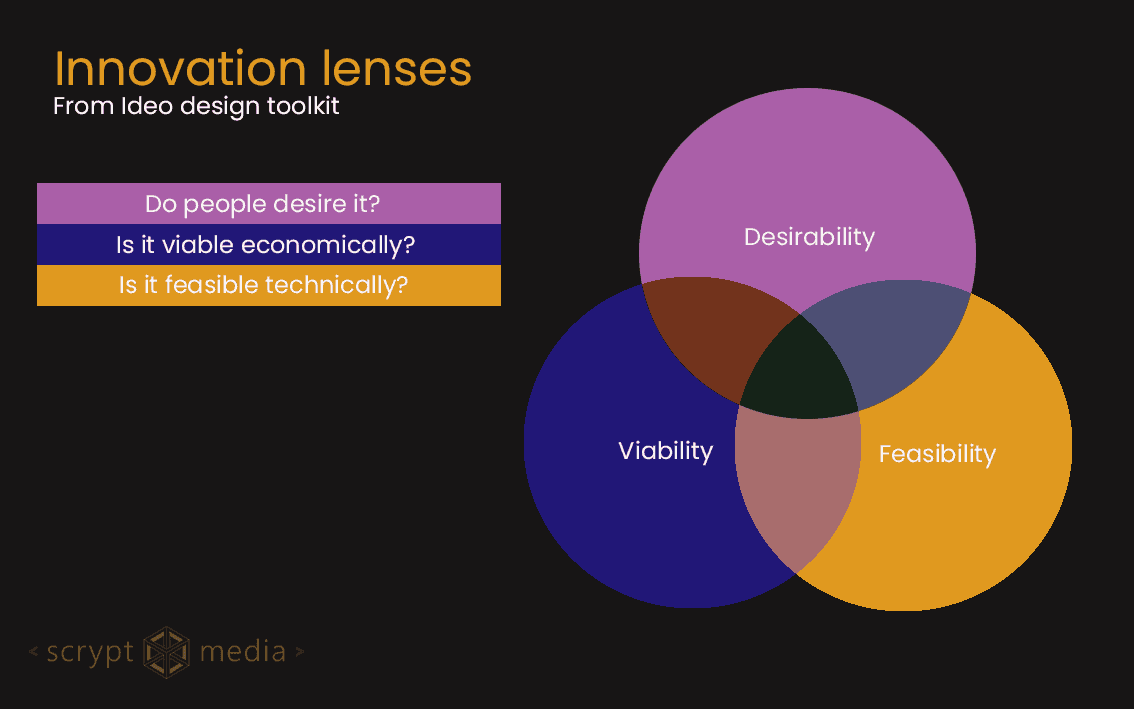We previously introduced human-centered design and design thinking. The introduced tools and frameworks are very useful for generating innovative ideas.
But how do you know you are developing a valuable product? How do you ensure you will validate your assumptions soon enough? ie. before spending months and years in development?
We will introduce here what make a product valuable. And how you can use Proof of Concept (POC), prototypes and MVP to confirm your assumptions.
What is a Valuable Product?
According to IDEO Human Center Design, the creators of Design Thinking approach, These are the key to valuable products: Desirability, Feasibility and Viability.
InnovationLenses

Viability
There are products used by millions of people but still struggle to be profitable. You don’t want one of those. The best product is bringing value to the users while being sustainable economically
It is very difficult to confirm the viability of your solution in advance. But you can increase the chances to not get it wrong. Spend sometimes defining your business model, crafting a solid business plan and a product vision and strategy. This seems obvious but, believe me! Many startups skip or rush these steps.
Feasibility
If you are developing a Wordpress website and you are having a Wordpress expert in your team, chances are he will be able to answer about the feasibility of the solution in 5 minutes. However, if the technology used is completely new for your team (or anyone else), it might be difficult to judge its feasibility before developing some small pieces of your solution. That’s what we call a “Proof of Concept”.
Desirability
This is probably the most difficult dimension to anticipate. Why? Because it involves human behavior… and humans are unpredictable. User surveys, prototyping, usability tests… will be your friends here.
Proof of Concept VS Prototype VS MVP
You preselected your idea and now you want to figure out how valuable it is. And you probably don’t want to figure it out after spending all your funds. Defining your personas and conducting user surveys will be a good start, but they will usually not be enough. For the two following simple reasons:
- You can’t always anticipate who your users are or will be.
- Even if you do, your users don’t usually know what they want and their answers can be misleading.
That’s where a POC, Prototypes and a well-thought MVP can be game changing.
If a picture is worth a thousand words, a prototype is worth a thousand meetings
IDEO.org
During our discussions, people are sometimes using the terms prototype, Proof of Concept and MVP interchangeably. Let’s have a closer look at them.
Proof of Concept
The main goal of a POC will be to prove or verify the feasibility of some technical aspect of your solution. If you want to develop a website with very little technical challenges, you will probably not need a POC. If you work for the first time with new technologies like Blockchain, IoT or AI and you want to explore the possibilities brought by them, developing a POC might be a good start. Finally, a POC is usually not meant to be launched in the market (it’s not a Pilot) but rather is limited to internal use.
Prototype
Prototypes are focused on features and user experience more than on technical aspects. their main purpose is to test the desirability and how user-friendly is your product. It can be full of bugs or even use some tweaks in the backend to focus on the frontend and the user experience. Finally, a Prototype is not the first draft version of your product before launch. Prototyping should be a continuous effort and successful companies use them for almost each sprint to confirm their assumptions and launch new features.
Minimum Viable Product (MVP)
The MVP will probably come after a POC (if needed) and the first prototypes. It will be the first version of you product launched in the market. Its main purpose will be to help you confirm some of the assumptions you made about the desirability and viability by constantly checking your metrics and getting feedback from your (very few at this point) users.
The MVP should contain the “primary” features of your products. For example, if you develop a mail client, it should be at least able to receive, send and forward mails, add several recipients… The MVP is not a draft version of your product, but rather a shippable product with limited features.
Summary
A valuable product should find the balance between desirability, viability and feasibility.
POC, Prototype and MVP are great tools to evaluate how valuable is your idea. They all have the same purpose: help you confirm your assumptions before you finish developing your full solution. But they’re not all suitable for the same situations. A POC will help you confirm the feasibility of some technical aspect. A Prototype will help you confirm that users will love your product and the new features. And finally, an MVP will be your first “shippable” product including the primary features.
Scrypt.Media guides emerging tech projects on their way to change the world. We bring the revolutionary ideas of our customers to life through the refinement of strategy, communication and usability. We help our customers navigate the difficulties of early stage organization, development and funding. In doing so, we help them to focus on the important thing – changing the world.
Khalid Belghiti
Khalid is an experienced project and product manager with technical engineering background.
His passion for innovation and emerging technologies pushed him to co-found Scrypt.Media with Maike.
Together, they intend to help Startups and Entreprises bring to market their impactful and disruptive solutions.
